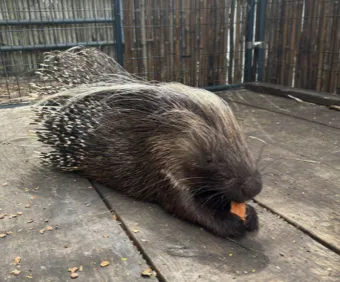
African Crested Porcupine
"Quillella"
Guess which porcupine species is the largest in the world.
If you guessed the African Crested Porcupine, you are right!
Overview:
● The African Crested Porcupine originated in sub-Saharan Africa, spanning savannas, forests, and rocky areas. Its range extends from Italy through North Africa to sub-Saharan Africa, excluding the Congo Basin and the southern tip of the continent.
● The African Crested Porcupine is closely related to other porcupine species within the Hystricidae family, such as the Indian Crested Porcupine and the Asiatic Brush-tailed Porcupine.
● The natural habitat of the African Crested Porcupine includes a variety of environments across sub-Saharan Africa, such as savannas, grasslands, forests, and rocky areas.
Physical Description: The African Crested Porcupine is a large rodent characterized by its prominent crest of sharp quills along its back. It has a robust body covered in dark brown or black fur, with lighter spines interspersed throughout. These spines, which can measure up to a foot in length, serve as its primary defense mechanism. The porcupine also has a distinctive white or yellowish crest of longer quills on its head and neck. Its face features small eyes, rounded ears, and strong, chisel-like incisors used for gnawing on vegetation. Overall, the African Crested Porcupine possesses a formidable appearance designed to deter predators.
Diet and Eating Habits: The African Crested Porcupine is primarily herbivorous, consuming a varied diet of plant materials such as roots, tubers, bark, fruits, and leaves. They have strong incisors for gnawing on tough vegetation and forage primarily at night.
Behavior and Personality: The African Crested Porcupine is primarily nocturnal and solitary, though occasionally found in
pairs or small groups. They're cautious and defensive, relying on their sharp quills for protection. When threatened, they may stomp their feet or raise their quills. Despite their appearance, they're generally docile and avoid confrontation. They're skilled diggers and climbers, creating burrows for shelter and occasionally seeking refuge in trees.
Domestication and Uses: The African Crested Porcupine has not been fully domesticated like some other animals. However, it is occasionally kept in captivity for various purposes. In some regions, they are hunted for their meat, considered a delicacy in certain cultures. Additionally, their quills are
sometimes used in traditional crafts and artwork. In captivity, they may also serve educational purposes in zoos or wildlife centers. While they can adapt to captivity, they require specialized care and handling due to their unique needs and defensive mechanism
Cultural Significance: The African Crested Porcupine holds cultural significance in various societies, symbolizing traits like protection and resilience. In African folklore, they're portrayed as wise and resourceful animals. Their quills are used in indigenous crafts, showcasing their cultural importance.
Economic Importance: The African Crested Porcupine holds economic importance primarily for its meat and, to a lesser extent, its quills. In some regions, porcupine meat is a delicacy, contributing to local economies through trade and culinary practices. Additionally, their quills are used in traditional crafts, adding to their economic value.
Conservation Status: The African Crested Porcupine is classified as "Least Concern" on the IUCN Red List due to its stable population and widespread distribution across sub-Saharan Africa. While localized threats exist, such as habitat destruction and hunting, overall conservation concerns are
relatively low. Continued monitoring and conservation efforts are important to ensure their long-term survival.
Takeaway:
The African Crested Porcupine, with its iconic quills and adaptability to various habitats, holds cultural significance and economic value in certain regions. While its conservation status is generally stable, localized threats exist, emphasizing the need for ongoing monitoring and conservation efforts. Overall, the porcupine serves as a symbol of resilience and resourcefulness, reflecting its importance in both natural ecosystems and human societies.
